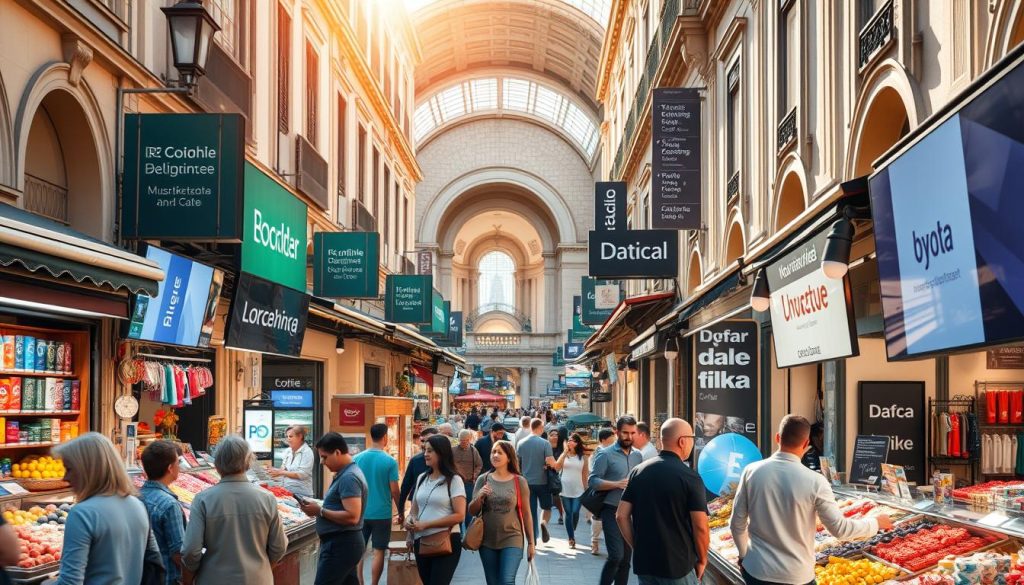The Italian business scene is full of variety and change, offering chances for new ideas and growth. Successful businesses in Italy know how to compete and grow in a changing market. They also value Italy’s rich culture. With a solid economy, Italian companies have grown a lot, keeping up with local and global trends.
Starting a business in Italy means building strong relationships and dealing with its complex rules. This article will look at what makes Italian businesses thrive. We’ll also share data on the current business scene, showing the challenges and opportunities faced by Italian companies.
Key Takeaways
- Italy’s business environment is stable and offers various growth opportunities.
- Establishing strong relationships is crucial for success in the Italian market.
- Understanding local bureaucratic processes can significantly impact business operations.
- Successful business models in Italy often blend tradition with innovative practices.
- Regional differences must be navigated to achieve effective business strategies.
- Investments in Italy are bolstered by a supportive funding community.
Understanding the Italian Business Landscape

The Italian business scene is a mix of personal ties, rules, and local quirks. Knowing these is key for anyone wanting to start a business in Italy.
Establishing Relationships
In Italy, trust is the foundation of business. Talks take longer, focusing on personal bonds rather than quick deals. Building these relationships can lead to strong partnerships.
Embracing Bureaucracy
Starting a business in Italy is complex. You need to pick a name, open a bank account, and get a tax code. It’s also important to understand the tax system, which includes regional taxes and VAT.
Understanding Regional Differences
Italy’s regions vary greatly, affecting business plans. The north has strong logistics, while the south has its own set of challenges and chances. Knowing these differences helps in choosing where to set up and how to market.
Key Industries Driving Economic Growth in Italy

Italy’s economy is strong thanks to several key sectors. Fashion, automotive, and machinery are leading the way. The fashion industry is famous for its quality and heritage.
The automotive sector, with companies like Fiat, brings new technology and innovation. In 2022, Italy’s GDP was $2.17 trillion, thanks to these sectors. Even with slower growth in 2023 and 2024, Italy stays strong. This is thanks to 3.7 million SMEs that create jobs and boost the economy.
The northern regions of Italy are where most of the work happens. They make up over 50% of the country’s income. This shows how important these sectors are for Italy’s economy. The machinery and robotics industries also play a big role in Italy’s growth.
Success Factors Behind Successful Business Models in Italy

The business scene in Italy is shaped by key success factors. A strong brand identity helps companies stand out. Quality products keep customers happy and loyal.
Customer engagement has grown, thanks to changing market needs. Over 30 years, new business models have emerged, thanks to tech advancements.
Understanding market segments and sizes is vital for success in Italy. Companies that innovate and adapt use Italy’s culture to their advantage.
Sustainable business models are now more important. They help companies be responsible, regardless of size. This approach gives them a competitive edge.
Businesses must keep up with changing consumer wants, especially for sustainability. Being resilient and adaptable is crucial for sustainable success in Italy.
Aligning business strategies with sustainability goals is key. It boosts a company’s social and environmental impact while increasing profits.
Companies that focus on value creation will do well in today’s fast-changing tech world.
Innovation and Tradition: The Balance that Works

Successful businesses in Italy show a great mix of innovation and tradition. Companies like De’Longhi use new tech with old skills. This way, they keep their heritage while improving their products. This balance helps them lead the market and keep customers loyal.
In the wine world, family businesses are key. They use their history to add value to their brand. This helps their sales grow. Planning for the future is crucial to keep the family business going. It’s about mixing new ideas with old traditions.
Innovation isn’t just about new products. It’s also about how businesses work. For example, AEFFE made 72.2% of its staff happy with flexible work. Their R&D team cut down on making prototypes thanks to new tech. This shows they value both innovation and their history.
Bringing digital into traditional markets is also important. This is what many businesses are doing. It helps them stay relevant in a changing world.
In the end, mixing tradition and innovation makes Italian businesses strong. Those who get this right can succeed and grow in a tough global market.
The Role of Artisanal Craftsmanship in Business Models

Artisanal craftsmanship is key to the Italian economy, seen in fashion, automotive, and food. Brands like Gucci and Prada stand out in luxury fashion with their top-notch tailoring and design. This makes Italy a leader in this field. Ferrari and Lamborghini also show Italy’s focus on perfection, combining skill and performance.
Family-owned businesses in Italy often have strong values that help them succeed. Companies like Barilla and Parmigiano Reggiano show Italy’s culinary mastery. They keep traditional skills alive while reaching global markets.
BertO, started in 1974 in Meda, is a great example. It has grown thanks to digital strategies and a focus on customer relationships. This includes online platforms and physical stores, boosting engagement in the artisanal sector.
BertO’s crowdcrafting lets customers join in the crafting process. Initiatives like BertOStory show the value of digital marketing in artisanal work. These efforts keep quality and tradition alive in today’s businesses.
Successful Business Models in Italy

The business scene in Italy is varied, showing how Italian brands mix old skills with new strategies. Companies like Ferragamo and Luxottica are great examples. They use smart marketing and innovation while keeping their Italian craftsmanship.
Italy is known for making high-quality products and offering custom services. This helps brands tell stories that people all over the world can connect with.
There’s a big growth in Italy’s green and sustainable franchises. For example, BikeBoom offers different plans for bike sharing and renting. Also, franchises like Pronto Fotovoltaico and EcoReversa help with green energy solutions.
Italy has 40 companies ready to make a global impact. The fashion and car industries are especially strong. Brands like Gucci and Ferrari are known for their innovative designs and top-notch craftsmanship.
Italy is the eighth-largest economy in the world, offering many chances for businesses to grow. This is especially true in luxury goods, healthcare, and green products. It’s a place where old and new business ideas meet, like in Italian tech startups.
The Influence of Luxury Brands on the Market

Luxury brands in Italy have a big impact on the economy. They show the power of brand legacy and market influence. Gucci and Prada are more than just fashion; they stand for quality, creativity, and exclusivity. They make a big economic impact.
About 80% of luxury sales are influenced by digital platforms. This means brands like Gucci focus more on their online presence. They change their marketing to meet the needs of today’s consumers, especially millennials, who make up half of Gucci’s sales since 2015.
Luxury brands also blend art and commerce, affecting many areas beyond fashion. They help people show who they are, seek social status, and signal their wealth through what they buy. This is especially true in high-end fashion, where being unique and handmade is key.
Gucci uses artificial intelligence to guess what people will buy and what they like. This shows they are always looking to improve and stay ahead with data. They also use new tech like NFTs and augmented reality for virtual try-ons. This keeps them at the top of market trends and makes customers more engaged.
These efforts highlight the link between luxury brands and their role in the market. They drive economic growth and set high standards in many industries.
Strategies for Navigating Italy’s Bureaucratic Environment

Starting a business in Italy can be tough due to its complex rules. Working with local experts who know the business laws can help a lot. They make sure you follow the rules well, from registering your business to handling taxes.
It’s important to be patient with the rules. Knowing Italy’s laws well can avoid delays. Entrepreneurs should spend time learning about the laws that apply to their business.
Knowing what documents you need and what rules to follow makes starting a business easier. Using digital tools can make dealing with the rules faster and easier.
Using online services can make following the rules more efficient. Also, learning from other successful businesses in Italy can teach you how to handle the rules better.
Being flexible with your plans is key, as rules can differ a lot in different parts of Italy. This helps your business not only survive but also grow in the future.
Regional Differences in Italian Business Practices

Italy’s varied regions show different business practices, shaped by culture and industry. Each area has its own traits, needing specific strategies to connect with local markets.
Milan, a financial centre, contrasts with Tuscany’s artisanal focus. This shows the market differences businesses face. Lombardy tops the franchise market, followed by Lazio, Campania, Emilia-Romagna, and Sicily. This shows a strong franchise presence in northern Italy.
With over 60,000 franchise outlets and 250,000 employees, knowing this is key for success.
Regional practices also shape the workforce. About 10% of Italy’s workers are from abroad, adding to the diversity in cities like Milan. This diversity meets Italy’s preference for top-down decision-making, where bosses make big calls.
Using local culture in marketing can build stronger brand loyalty. Italy’s laws on fair work practices also guide businesses to adapt to regional norms.
Case Study: De’Longhi and Its Global Success

De’Longhi is a top example of success in the consumer electronics world. They are known for their stylish kitchen appliances. Their mix of new technology and Italian design has made them a global leader.
De’Longhi has grown by focusing on the global market. They bought Capital Brands, which helped them in the food sector. They own famous brands like De’Longhi, Kenwood, and Braun, making them big in small appliances.
They care about quality and the environment. They have a plan that values people, focuses on sustainable products, and keeps their operations green. They also have a team and guidelines to help with being responsible.
Recently, De’Longhi bought 40% of Eversys, aiming to improve their work. Eversys got ISO 9001:2015 and ISO 45001:2018, showing their dedication to quality and safety. This move is expected to boost growth and innovation in the field.
The Impact of Sustainability on Italian Businesses

In recent years, sustainability has become key for Italian businesses. They now focus on eco-friendly methods like renewable energy and reducing waste. This shift helps attract eco-conscious consumers and build brand loyalty.
Companies are also working towards ethical production. They aim to meet the United Nations’ Sustainable Development Goals (SDGs). These goals include affordable energy, decent work, and action on climate change.
Italian SMEs play a big role in this change. With over 4 million enterprises, they are vital to the economy. They employ around 13 million people and create over 65% of Italy’s added value.
More than 60% of these SMEs invest in digitalisation. This aligns with their sustainability goals.
Italy is investing in green infrastructure. It has solar farms and wind power installations. The government offers incentives like feed-in tariffs and tax rebates to encourage renewable energy use.
Leading companies are adopting sustainable practices in various sectors. This includes agriculture and tourism. They aim for economic growth while protecting the environment and improving social well-being.
Investment Opportunities in Italy’s Thriving Sectors

Italy is offering many investment chances that attract both local and foreign investors. The country’s GDP grew by 4.0% in 2022, but fell to 0.9% in 2023. This shows Italy’s economy is strong, even when things change. Areas like renewable energy, tech, and tourism are growing fast.
Foreign direct investment (FDI) in Italy jumped to $26.84 billion in 2022, up from $16 billion in 2021. The Italian venture capital scene is getting more active. For example, the Italian Founders Fund plans to back about 25 companies in the next four years. This shows more people are interested in Italian startups.
The manufacturing sector is key to Italy’s economy, making up 81% of exports in 2022. It’s likely to keep drawing investors because of its importance. The tourism sector, which adds about 6% to the economy, also highlights Italy’s varied economy.
Networking and Relationship Building in Italy

Networking in Italy is key to business success. Building personal connections leads to strong business ties, thanks to Italy’s focus on trust and reliability. Joining local events, conferences, and workshops boosts visibility and helps in making meaningful connections. Keeping in touch with contacts is vital to grow these relationships.
Sharing common interests with potential partners makes discussions easier. This can lead to successful collaborations, opening up new opportunities for growth and innovation. Knowing the local customs is important, as different parts of Italy have their own ways of networking. For example, the North is more formal, while the South values personal connections.
Social media has changed how we network, allowing entrepreneurs to connect online and find resources. This digital shift helps startup founders get valuable information, work together, and even find funding online. Having a strong online presence can help you find opportunities and build relationships that might be harder to find in person.
As networking in Italy changes, using both old and new methods is crucial for lasting business success. A strong network not only helps businesses grow but also creates a sense of community among entrepreneurs facing the Italian market’s challenges.
Understanding the Role of Local and International Partnerships

Successful Italian businesses know how important local and international partnerships are. These partnerships help them grow by combining local knowledge with global skills. They also help companies understand what customers want, making their products better for local tastes.
By working with international partners, businesses can reach more people. This helps them grow beyond their local markets. It’s a key part of their business strategy.
Good partnerships share the same vision and values. Local partners know the market well and help navigate it. Without these partnerships, businesses might struggle to enter new markets.
This could lead to problems and harm their brand. Choosing the right partners is crucial for success.
Italian companies are now looking to grow globally. Going international can spread out their income, reducing risks. It makes their business stronger and more flexible.
It also brings in new talent and ideas, making them more competitive. This is key for their success.
Doing a deep market analysis is vital for these partnerships. Without it, businesses might not fit well with local markets. So, Italian businesses can do well by working with local partners and reaching out globally.
Adapting Global Business Models to the Italian Context

For international businesses aiming to enter the Italian market, adapting their models is crucial. It’s important to understand the local market to create effective strategies. This means recognising that regional differences within Italy can be as important as those between countries, affecting business practices.
Industry cultures often go beyond national borders, shaping communication and practices. Businesses must realise that personal factors like age and background can be more influential than broad cultural trends in international interactions. A customised approach is necessary, especially with the need for digital skills training in Italy from 2024-2028.
Also, knowing the mix of traditional and modern practices is key for market success. Respect for authority and building personal relationships are crucial in Italy, where trust is highly valued. This understanding can help businesses tailor their strategies to fit the Italian context while using global insights.
The Future of Business Models in Italy: Trends and Predictions
Italy is moving into the digital age fast. New business models will emerge, focusing on digital transformation, e-commerce, and sustainability. Small businesses in Italy are using Industry 4.0 to stay ahead. They can quickly respond to market changes, making them more competitive and innovative.
These technologies help automate tasks and understand customer needs better. This leads to better services and more loyal customers.
The entertainment and media sector is also changing. Global revenue is growing, but CEOs see big changes coming. They think their current plans might not work in ten years.
Advertising is expected to hit $1 trillion by 2026. This shows the need for flexible business models.
In the wine industry, Italy is a leader with a market worth over $300 billion. Online sales are key, with fast growth expected. Italy is embracing new tech and markets, focusing on sustainability too.









